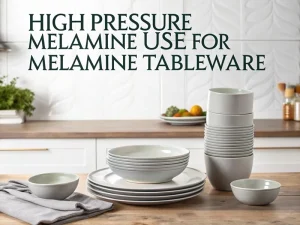
High Pressure Nelamine Use For Melamine Tableware Advantage
Tech Blog High Pressure melamine Use For Melamine Tableware Melamine tableware has become a staple for households, restaurants, and catering services worldwide due to its

Melamine is often found on lightweight tableware, fashionable cabinets, and composite flooring. Because it is a popular and widely used material. But a persistent issue still exists that has raised concerns among health-conscious consumers: Does melamine contain formaldehyde?
In short, the answer is: Yes, formaldehyde is a key component in the manufacture of melamine products, but it undergoes chemical transformation and is locked into a stable structure in the final solid product.
Understanding this difference is key to understanding its security. Formaldehyde is not simply present on a plate like raisins. On the contrary, it is a fundamental component that has been transformed into a new substance.
This article explains the relationship between melamine and formaldehyde, how they are used together, and the knowledge needed to use these products safely.
To answer whether melamine contains formaldehyde, two core concepts need to be clarified first:
Melamine powder: an independent organic compound (chemical formula: C₃H₆N₆). It is a white crystalline powder derived from urea, with a rigid triazine ring structure. Pure melamine does not contain formaldehyde—it is a single, unique molecule.
Melamine formaldehyde resin: a polymer synthesized from melamine and formaldehyde. This resin is a hard, heat-resistant plastic produced by reacting melamine with formaldehyde (CH₂O) under controlled conditions. It is widely used in tableware, laminated countertops, and electrical components. It is a highly durable and stable thermosetting plastic. In the final cured state, formaldehyde no longer exists in a “free” form, but is chemically bonded and locked in a rigid three-dimensional network.
Core difference: Pure melamine does not contain formaldehyde, but melamine formaldehyde resin made from melamine may retain trace amounts of unreacted formaldehyde.
The correlation between the two stems from the production process of melamine-based products – the manufacturing of MF resin relies on the chemical reaction between melamine and formaldehyde:
Hydroxymethylation: Under alkaline conditions, formaldehyde molecules combine with the amino group (- NH ₂) of melamine to form an intermediate called hydroxymethylmelamine.
Crosslinking: These intermediates then react further under heating and acidic conditions to form a rigid three-dimensional network structure, known as MF resin.
In an ideal state, all formaldehyde will completely react with melamine. However, achieving a 100% conversion rate in industrial production is difficult, so a small amount of unreacted formaldehyde may remain in the final resin product.
The residual formaldehyde content in melamine-based products depends on production quality and intended use. Regulatory agencies have established strict standards to ensure safety:
Food contact products: Strict limits are implemented by agencies such as the US FDA and the EU EFSA. For example, EU Regulation (EU) 10/2011 stipulates that the amount of formaldehyde transferred from melamine plastics to food must be ≤ 0.15 milligrams per kilogram of food.
Non-food products: Laminated boards, furniture, or adhesives may slowly release small amounts of formaldehyde during use (known as the “release” phenomenon), but standards such as California CARB (Composite Wood Products Regulations) set limits on the amount released to protect indoor air quality.
In practical situations, the amount of formaldehyde released by qualified melamine products is well below the threshold for human health.
Not so—melamine-based products produced in accordance with safety standards are usually safe for their intended use. The residual formaldehyde in compliant products is extremely low, and the risk is minimal for most people.
However, it should be noted that formaldehyde is a known irritant substance and is classified as a Class 1 carcinogen by IARC at high concentrations. Therefore:
Avoid high-temperature use: High-temperature environments (such as placing melamine tableware in a microwave) can accelerate the release of formaldehyde and melamine.
Choose certified products: Prioritize products labeled as compliant with FDA, German LFGB, or Chinese GB 4806 standards – these certifications ensure formaldehyde levels are within safe limits.
View certification label: Priority should be given to products labeled “food grade” or compliant with national safety standards.
Avoid high-temperature scenarios: Do not put melamine tableware in the microwave, hold boiling water, or place it in a high-temperature oven.
Maintain indoor ventilation: When using melamine-based furniture or laminated boards, ensure good airflow to reduce formaldehyde accumulation after release.
Replace aging products: Melamine products with scratches or damage may accelerate the release of formaldehyde (and melamine), and should be replaced promptly when signs of wear appear.
Pure melamine (as a chemical substance) does not contain formaldehyde. However, melamine formaldehyde resin—the raw material for the vast majority of melamine products—may contain trace amounts of unreacted formaldehyde due to production process limitations.
In compliant and qualified products, these residual amounts are strictly controlled within a safe range, and the risk of daily use is extremely low. By selecting high-quality products and avoiding high-temperature use, exposure risks can be further reduced. The scientific community and regulatory agencies unanimously agree that melamine is the ideal choice for your home safety as long as it is used for its intended purpose.

Tech Blog High Pressure melamine Use For Melamine Tableware Melamine tableware has become a staple for households, restaurants, and catering services worldwide due to its

Tech Blog Melamine packaging For manufacturers, inaccurate packaging not only fails to meet national standards but also increases labor costs and the risk of product

Tech Blog How to Detect Melamine in Textiles? Melamine powder, a nitrogen-containing heterocyclic compound, is widely used in flame-retardant textiles and plastic products due to

JINGJIANG MELAMINE POWDER
© JINJIANG MELAMINE